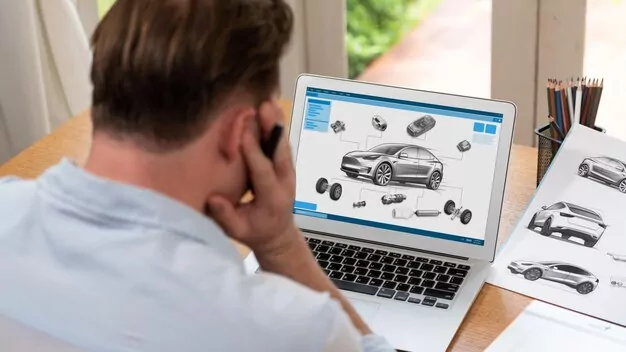In today’s digital age, a well-designed website is crucial for dealerships looking to attract and retain customers.
According to a study by Google, 90% of car buyers use the internet to research vehicles before making a purchase, and 76% of them visit a dealership’s website before visiting the dealership in person.
This means that a dealership’s website is often the first impression potential customers have of the business, and it plays a significant role in shaping their perceptions and influencing their purchasing decisions.
However, many dealerships struggle to create a website that effectively showcases their inventory, services, and brand. Common mistakes include cluttered layouts, poor navigation, and lack of mobile optimization.
To help dealerships avoid these pitfalls and create a website that truly resonates with their target audience, we’ve put together 7 essential design tips. In this blog post, we’ll explore each of these tips in detail, helping dealerships improve their website design and enhance the overall user experience.
Let’s get started!
7 Essential Design Tips for Your Dealership’s Website
1. Responsive Design
In today’s digital age, it’s crucial that your dealership’s website is optimized for all devices, including smartphones, tablets, and desktop computers. A responsive design ensures that your website automatically adjusts to fit the screen size of the device it’s being viewed on, providing an optimal user experience regardless of how users choose to access your site.
Responsive design not only enhances user experience but also improves your website’s search engine rankings. Google recommends responsive design as the best approach for mobile-friendliness, and it’s a critical factor in their mobile-first indexing strategy.
To implement responsive design, you can use a variety of techniques, such as flexible grids, media queries, and responsive images. Flexible grids allow you to create a layout that adapts to different screen sizes, while media queries enable you to apply different styles based on the device’s screen size.
Responsive images automatically adjust their size and resolution to match the device’s screen resolution, reducing load times and improving user experience.
2. User-Friendly Navigation
Navigation is a critical aspect of your dealership’s website as it helps users find the information they need, quickly and easily. A well-designed navigation system can significantly improve user experience and increase engagement.
To create a user-friendly navigation system, consider the following tips:
- Use clear and concise labels for your menu items, so users can easily understand what they’ll find when they click on them.
- Organize your menu items logically, with the most important items at the top level and subcategories beneath them.
- Use visual cues, such as icons or images, to help users understand the different sections of your website.
- Include a search bar in your navigation menu, so users can quickly find specific information.
- Ensure your navigation menu is consistent across all pages of your website, so users can easily find their way around.
3. High-quality Imagery
Imagine the vehicles in your dealership gleaming under bright, fluorescent lights. Ah! A sight to behold! But what if this image is not caught on the basic cameras you use to capture your beautiful inventory? How will those 76% customers know your dealership’s magnificent collection?
This is exactly why high-quality imagery is essential for a dealership website. It helps showcase your inventory and services in the best possible light. Use high-resolution images that are clear and well-lit, and ensure they’re optimized for web use to load quickly on your pages.
In addition to showcasing your inventory, consider using images that highlight your dealership’s facilities, staff, and customer testimonials. This will help create a more personal connection with your audience and give them a better understanding of what your dealership has to offer.
Expert Tip!
As many of your customers will be new parents and families, they will often come in with their kids to buy a new car. So, if you have a designated play area for kids and children, ensure you have captured that place in your high resolution camera and uploaded it on your website.
This will attract customers who want to visit your dealership but cannot leave their kids with the neighbors.
Also, if you have a designated play area for children, it will show that you care about the diverse needs of your customers and want to ensure that the parents can roam the dealership freely while their kids are occupied with toys and games.
And don’t shy away from showcasing the fully stocked pantry that contains coffee, tea, doughnuts and other snacks for your customers. It’s all in the pictures!
4. Strong Call-to-Action (CTA)
A clear and prominent call-to-action (CTA) is essential for encouraging users to take the next step and engage with your dealership. CTAs can be used to prompt users to schedule a test drive, request a quote, or contact your dealership for more information.
To create an effective CTA, consider the following tips:
- Use contrasting colors to make your CTA stand out from the rest of your website.
- Use clear and concise language that tells users what will happen when they click on the CTA.
- Place your CTA in a prominent location, such as above the fold or in the hero section of your homepage.
- Use animation or other visual effects to draw attention to your CTA.
- Test different variations of your CTA to see which one performs best.
5. Streamlined Content
The content on your dealership’s website should be clear, concise, and easy to read. Avoid using jargon or overly technical language that might confuse users. Instead, focus on creating content that’s informative and helpful, and that addresses the needs and concerns of your target audience.
To streamline your content, consider the following tips:
- Use short paragraphs and bullet points to break up long blocks of text.
- Use headings and subheadings to create a clear hierarchy of information.
- Use images and videos to support your content and make it more engaging.
- Keep your content up-to-date and relevant to your audience’s needs.
- Use clear and concise page titles and meta descriptions to help users understand what they’ll find on each page of your website.
6. Fast Load Times
Slow-loading websites can be frustrating for users, and they can also negatively impact your dealership’s search engine rankings. To ensure fast load times, consider the following tips:
- Optimize your images for web use by compressing them and reducing their file size.
- Use a content delivery network (CDN) to reduce the distance your website’s files have to travel to reach users.
- Minify your website’s code and eliminate unnecessary plugins or scripts.
- Use a fast web hosting service that’s optimized for your dealership’s website.
- Test your website’s load times on different devices and networks to ensure consistent performance.
7. Consistent Branding
Consistent branding is essential for building trust and credibility with your audience. Make sure your dealership’s website reflects your brand’s identity, including your logo, color scheme, and messaging.
To ensure consistent branding, consider the following tips:
- Use your dealership’s logo prominently on your website, and ensure that it’s consistent across all pages.
- Use a consistent color scheme and typography throughout your website.
- Use imagery and graphics that align with your brand’s identity.
- Ensure that your website’s content and messaging aligns with your brand’s values and mission.
- Use consistent branding across all of your dealership’s online platforms, including social media and email marketing.
The Bottom Line
A well-designed website is essential for your dealership’s online success and we have already established the importance of having one.
So, by implementing a responsive website design, incorporating measures for user-friendly navigation, high-quality imagery, strong CTAs, streamlined content, fast load times, and consistent branding, you can create a website that engages users, builds trust, and ultimately drives sales.
Remember to continually test and refine your website’s design to ensure that it’s meeting the needs of your audience and achieving your business goals.
Explore more resources
Maximize Efficiency & Customer Satisfaction in Your Dealership
This article aims to provide you with the knowledge necessary to optimize your dealership’s performance and ensure delighted customers every…
How AI & Big Data is Shaping the Future of Automotive Retail
In this blog, we’ll explore how data and AI are reshaping the automotive retail industry, from manufacturing to the driving…
4 Best Practices to Increase Positive Online Reviews
When you are in the auto industry, you want to be consistently showcasing positive experiences and excellent reviews, but to…
Stay up to date
Subscribe to get the latest auto industry insights from Autosoft experts






